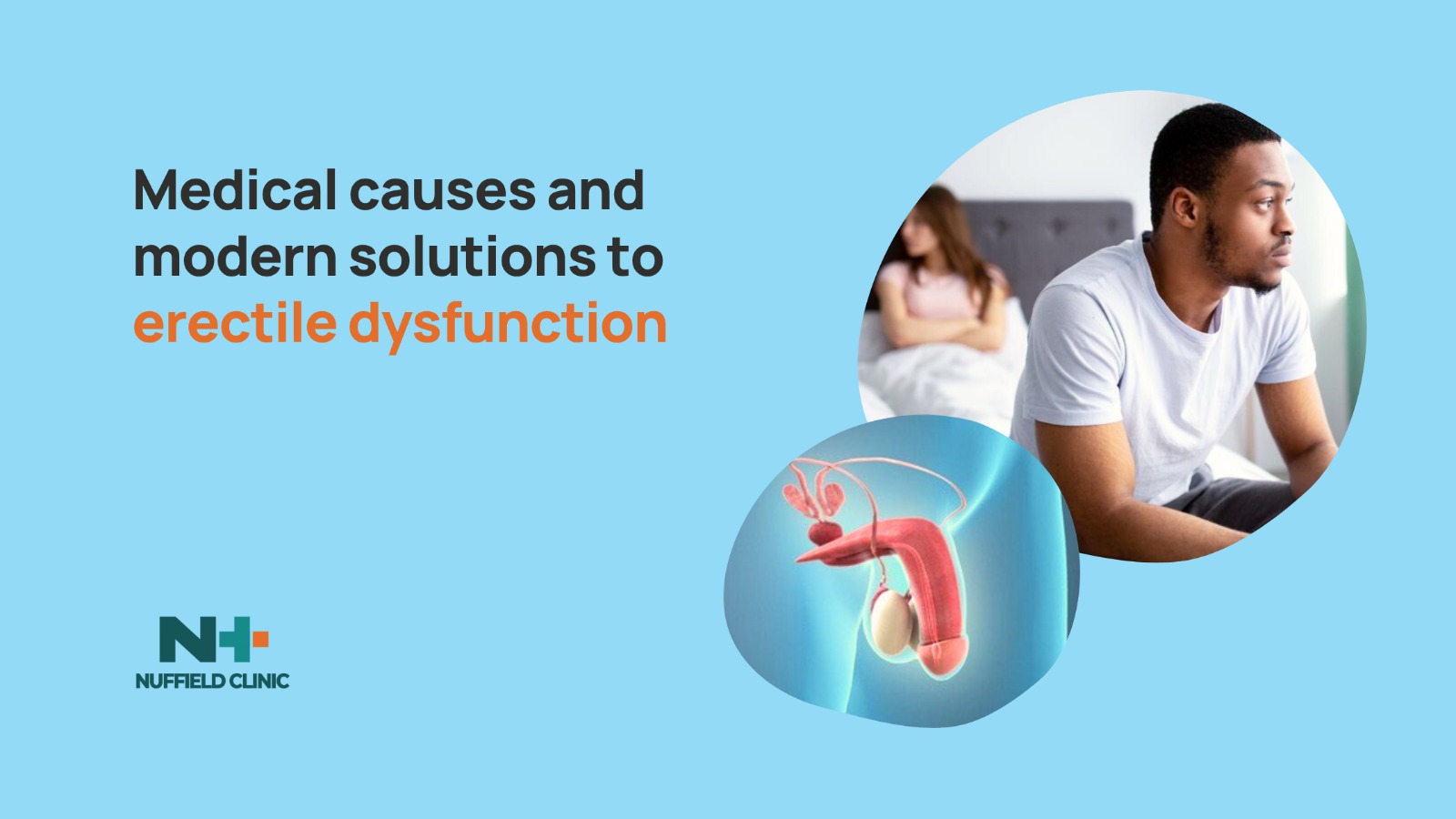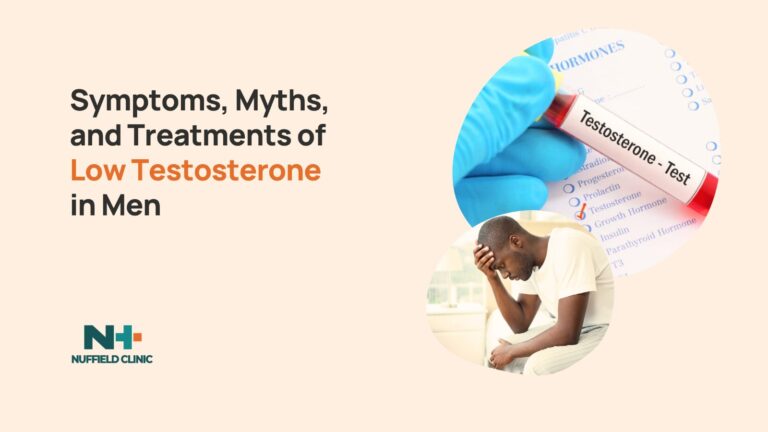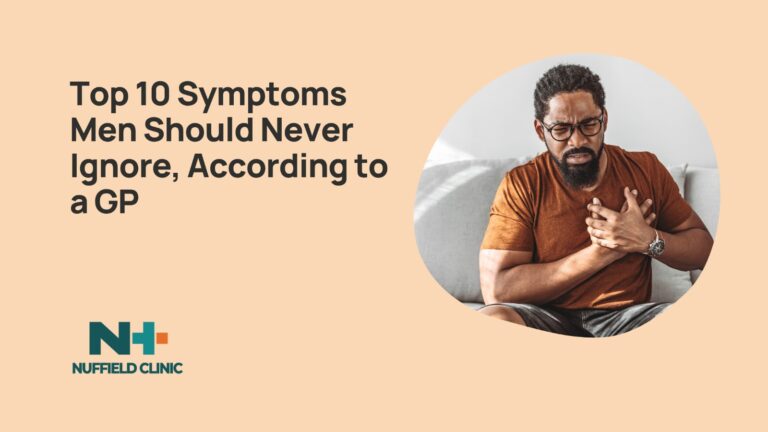Medical causes and modern solutions to Erectile Dysfunction

What causes erectile dysfunction, and how do you remedy it? Erectile dysfunction (ED) affects a significant portion of the male population, yet remains misunderstood by many. If you are experiencing difficulty with achieving or maintaining an erection, this article is meant for you. As a Physical Therapist at Nuffield Clinic, I understand how intimately ED can affect a man’s sense of self, relationships, and overall quality of life. More importantly, ED is not only a treatable condition but often a critical indicator of deeper medical issues that require timely attention.
See also: Symptoms, Myths, and Treatments of Low Testosterone in Men
In this article, we will examine the medical causes of ED, how it is diagnosed, and the broad spectrum of treatments now available, from evidence-based conventional therapies to modern, research-driven innovations. Our aim is to guide you toward informed conversations with your healthcare provider, and ultimately, toward better health outcomes and restored confidence.
Understanding erectile dysfunction
Erectile dysfunction, also referred to as impotence, is clinically defined as the persistent inability to achieve or sustain an erection sufficient for satisfactory sexual performance. This condition affects an estimated 30 million men in the United States alone, and over half of all men between the ages of 40 and 70 will experience some degree of ED in their lifetime. Contrary to popular belief, ED is not a normal consequence of ageing, although its prevalence increases with age.
ED does not always present as a complete inability to attain an erection. Some men report inconsistent erections or find that they cannot maintain an erection long enough to complete intercourse. When left unaddressed, ED can affect mental health, contributing to anxiety, depression, low self-esteem, and strained relationships. In many cases, ED can signal underlying vascular issues, particularly because the blood vessels supplying the penis are among the smallest in the body and may show signs of dysfunction earlier than larger arteries.
Medical causes of erectile dysfunction
The underlying causes of ED are often complex, involving a combination of physical, psychological, and lifestyle factors. Approximately 90 per cent of cases have a physiological origin, while emotional or psychological elements may contribute to or exacerbate symptoms.
Circulatory and cardiovascular causes are the most commonly identified. Atherosclerosis, in particular, reduces blood flow to the penis by narrowing arteries, including the penile arteries. High blood pressure and elevated cholesterol levels can compound this effect, damaging blood vessel walls and impeding circulation. Heart disease and heart failure further diminish the heart’s ability to maintain adequate blood flow throughout the body, including to the erectile tissues.
Endocrine-related conditions also play a significant role. Men with diabetes are at high risk, with poor glucose control damaging nerves and blood vessels essential to erectile function. Hormonal imbalances such as low testosterone, hyperthyroidism, hypothyroidism, and elevated prolactin levels can reduce libido and erectile capacity. Although low testosterone alone rarely causes ED, it often interacts with other conditions to contribute to sexual dysfunction.
Neurological conditions can interrupt the brain-to-penis signalling pathways needed to initiate and sustain an erection. Diseases such as Parkinson’s, Alzheimer’s, multiple sclerosis, and stroke can all have this effect. Injuries to the spinal cord, as well as nerve damage from prostate surgery or pelvic trauma, are additional causes.
Other chronic illnesses, including kidney disease, obesity, and chronic obstructive pulmonary disease, can indirectly contribute to ED. Structural penile conditions like Peyronie’s disease or priapism may also result in difficulties in achieving erections.
Many commonly prescribed medications list ED as a side effect. These include certain antidepressants, anti-anxiety medications, blood pressure drugs such as thiazide diuretics and beta-blockers, antihistamines, chemotherapy agents, and opioid pain relievers. Patients should not alter their medication without medical supervision, but should inform their physician if ED symptoms begin after starting a new drug.
Emotional and psychological influences
The brain is essential in triggering the sequence of physical events that produce an erection. Psychological issues may not always be the primary cause, but they can significantly interfere with sexual arousal. Depression, anxiety, and chronic stress are known to blunt libido and interrupt the arousal process. Concerns about sexual performance can lead to anticipatory anxiety and create a cycle of repeated ED episodes.
Low self-esteem, body image issues, unresolved relationship tensions, and fear of intimacy can all impact the ability to become sexually aroused. In such cases, counselling or therapy often forms a core part of the treatment plan.
Lifestyle contributors
ED is also linked to modifiable lifestyle behaviours. Smoking is particularly harmful to blood vessel health and is strongly associated with ED. Excessive alcohol use and illicit drug use, including cocaine, marijuana, and opioids, can depress central nervous system activity and impair vascular function.
A sedentary lifestyle and obesity can contribute to vascular problems, hormone disruption, and diminished sexual confidence. Poor sleep habits, especially chronic sleep disorders like sleep apnea, are also known to negatively affect testosterone levels and sexual performance.
Diagnosing erectile dysfunction
Diagnosis of ED begins with a comprehensive evaluation. A healthcare provider will ask about your medical history, current medications, psychological health, and relationship factors. Discussion of nocturnal or early morning erections can help determine whether the cause is physical or psychological.
A physical examination may include an inspection of the genitals and assessment for signs of hormonal imbalance or nerve damage. If urinary symptoms are present, a prostate exam might also be conducted.
Laboratory tests may follow, including blood tests to assess testosterone levels, blood glucose, cholesterol, and thyroid function. A urinalysis may reveal signs of diabetes or infection. Imaging tests, such as penile Doppler ultrasound, can measure blood flow and identify vascular abnormalities.
Specialised assessments such as penile biothesiometry or nocturnal erection monitoring may be used to distinguish psychological from organic causes. Mental health evaluations are useful when emotional or relational factors are suspected.
Treatment options
Treatment for ED depends on the root cause and may include a combination of approaches. The first step often involves improving modifiable lifestyle habits.
Quitting smoking, reducing alcohol intake, achieving a healthy body weight, and increasing physical activity can improve vascular and hormonal health. Managing psychological conditions and improving sleep quality are also essential steps.
Oral medications, particularly phosphodiesterase type 5 (PDE5) inhibitors, are commonly prescribed. These include sildenafil, tadalafil, vardenafil, and avanafil. They work by enhancing the effects of nitric oxide, increasing blood flow to the penis in response to sexual stimulation. They are not suitable for all men, especially those on nitrate medications or with certain cardiac conditions, and they may have side effects such as headache, flushing, or nasal congestion.
Other pharmaceutical options include self-injection therapy with medications like alprostadil or combination drug injections, intraurethral suppositories, and testosterone replacement therapy when hormonal deficiencies are confirmed. TRT can be administered through gels, injections, patches, or pellets, often in conjunction with other treatments.
Non-pharmacological treatments include vacuum erection devices, which use a mechanical pump and a constriction ring to produce and sustain an erection. In cases where conservative treatments fail, penile implants offer a surgical solution. These devices are placed inside the penis and can be inflatable or semi-rigid. While more invasive, they yield high satisfaction rates among patients and their partners.
Counselling or sex therapy is recommended when ED has a significant emotional or relational component. This may be done individually or with a partner and can address performance anxiety, communication difficulties, and underlying mental health conditions.
Emerging and experimental therapies
Several modern therapies are being investigated for the treatment of ED, although most remain experimental.
Shockwave therapy uses low-intensity acoustic waves to improve blood flow and promote tissue regeneration. Platelet-rich plasma (PRP) therapy, also known as the P-Shot®, involves injecting the patient’s own blood plasma into the penis to stimulate repair. Both are under investigation and not yet widely endorsed by regulatory authorities.
Stem cell therapy aims to regenerate erectile tissues using injected stem cells, but it is still in early-stage research. Low-intensity laser therapy and vascular stenting for localised arterial damage are also under exploration.
Other experimental options include topical alprostadil cream, botulinum toxin (Botox) injections, gene therapy, and even penile transplantation, which remains rare and reserved for extreme trauma cases.
So erectile dysfunction is a complex condition that can significantly affect physical and emotional well-being. It is often an early marker of more serious medical conditions, particularly those affecting the cardiovascular system. Might I add that recognising the underlying cause is as essential to choosing the most appropriate and effective treatment.
A wide range of therapies exists, from lifestyle changes and oral medications to advanced medical devices and investigational treatments. Open dialogue with a qualified healthcare provider is key to developing a treatment plan that reflects your needs and preferences.
At Nuffield Clinic, we emphasise a multidisciplinary approach that considers not only physical therapy, but also nutrition, emotional wellness, and long-term lifestyle support. For many men, the path to renewed sexual health begins with education and a willingness to seek professional care. Book an appointment to see a specialist today.




